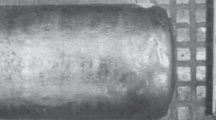Abstract
Dense defect-free 10Kh3A steel ingots with an overequilibrium nitrogen content (0.1–0.17 wt %) are formed by electroslag remelting under nitrogen pressure in a DEShP 0.1 pilot furnace (All-Russia Institute of Aviation Materials). A method is developed for calculating the solubility of nitrogen in multicomponent melts, including model steels, under its atmospheric and working pressure in the furnace chamber. This method determines the nitrogen content in liquid and solid metals and can be used to form 10Kh3A steel ingots with a dense homogeneous structure. Distributions of nitrogen and other alloying elements over the ingot height and cross section are found. The calculated nitrogen solubility in the metal is in agreement with experiment one.






Similar content being viewed by others
REFERENCES
E. N. Kablov, “Modern materials are the basis of innovative modernization of Russia,” Metally Evrasii, No. 3, 10–15 (2012).
L. G. Rigina, Ya. M. Vasil’ev, V. S. Dub, et al., “Nitrogen alloying of steels,” Elektrometallurgiya No. 2, 14–19 (2005).
A. G. Shalimov, V. N. Gotin, and N. A. Tulin, Intensification of Special Electrometallurgical Processes (Metallurgiya, Moscow, 1988).
Yu. V. Latash and B. I. Medovar, Electroslag Remelting (Metallurgiya, Moscow, 1970).
R. A. Swift, Advantages of Electroslag Remelted Steels: Offshore Technology Conference (1977). https://doi.org/10.4043/2799-MS
A. G. Glebov and E. I. Moshkevich, Electroslag Remelting (Metallurgiya, Moscow, 1985).
S. N. Zherebtsov, “Features of metal refinement from nonmetallic inclusions during electroslag remelting,” Omskii Nauchn. Vestnik, No. 1 (26), 75–77 (2004).
H. Halfa and A. M. Reda, “Electroslag remelting of high technological steels,” Miner. Mater. Charact. Eng. No. 3, 444–457 (2015).
Ts. V. Rashev, High Nitrogen Steels. Metallurgy under Pressure (Prof. Marin Drinov, Sofia, 1995).
G. Stein and J. Menzel, “High pressure electroslag re-melting—a new technology of steel refining,” Int. J. Mater. Prod. Techn. 10 (3–6), 478–488 (1995).
M. Bartosinski, J. H. Magee, and B. Friedrich, “Improving the chemical homogeneity of austenitic and martensitic stainless steels during nitrogen alloying in the pressure electro slag remelting (PESR) process.” www.metallurgie.rwth-aachen.de/…/aertosinskimae_ id_4297
O. A. Bannykh, V. M. Blinov, and M. V. Kostina, “Structure and properties of low-alloyed high-nitrogen martensitic steels,” Metalloved. Term. Obrab. Met., No. 2, 3–7 (2003).
L. G. Rigina, “Research and development of ESR and PESR technologies for chromium–manganese nitrogen-alloyed steels,” Cand. Sci. (Eng.) Dissertation, TsNIITMASh, Moscow, 2005.
V. S. Dub, “The study of noncentered segregation and the development of methods to suppress its development in large ingots,” Cand. Sci. (Eng.) Dissertation, TsNIITMASh, Moscow, 1980.
Author information
Authors and Affiliations
Corresponding author
Additional information
Translated by T. Gapontseva
Rights and permissions
About this article
Cite this article
Kostina, M.V., Rigina, L.G., Blinov, V.M. et al. Technology for Producing a Low-Alloy Martensitic 10Kh3A Steel with an Overequilibrium Nitrogen Content. Russ. Metall. 2019, 594–600 (2019). https://doi.org/10.1134/S0036029519060132
Received:
Revised:
Accepted:
Published:
Issue Date:
DOI: https://doi.org/10.1134/S0036029519060132




